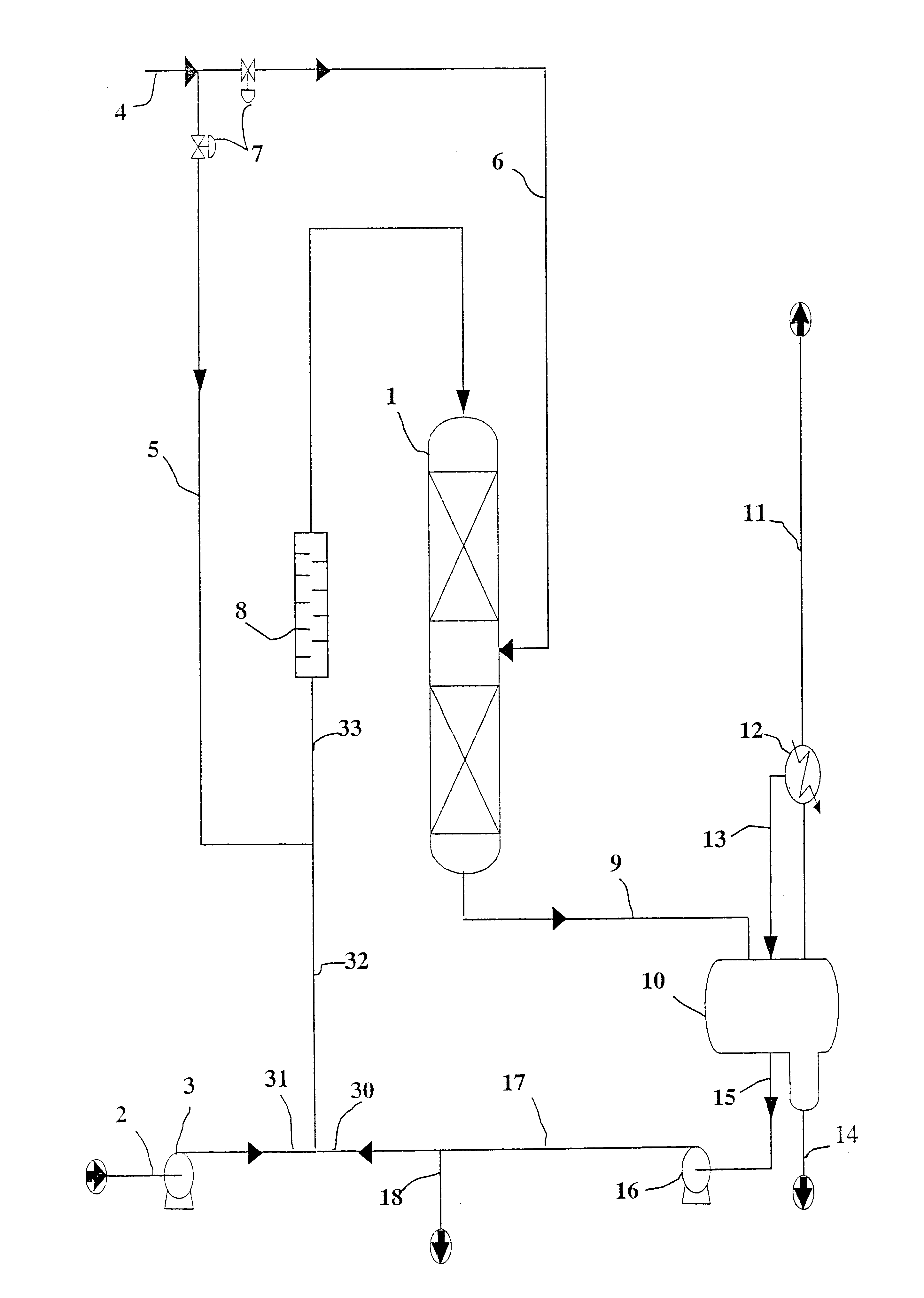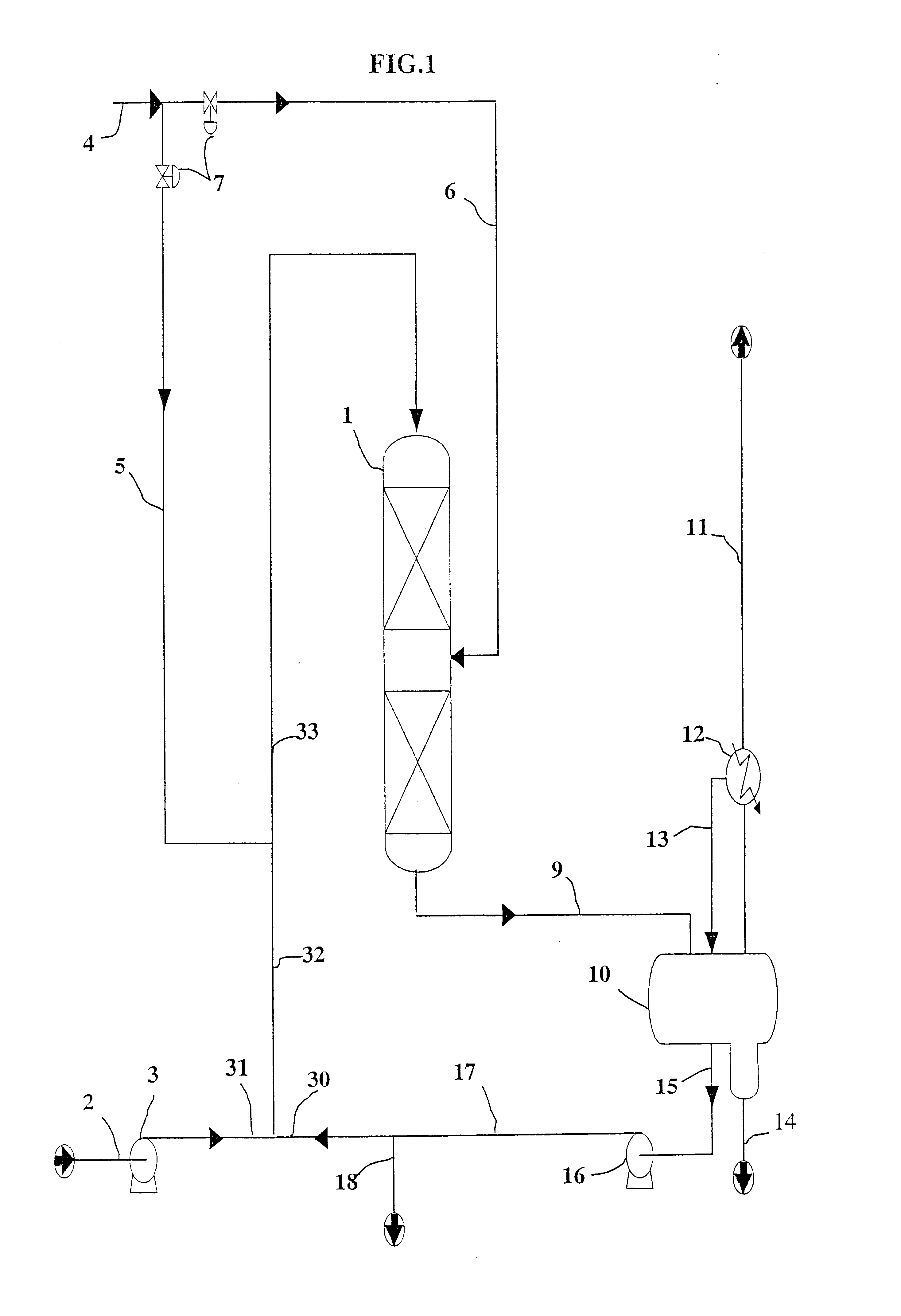Process for hydrogenating cuts containing hydrocarbons, in particular unsaturated molecules containing at least two double bonds or at least one triple bond
a technology of hydrogenation cut and hydrocarbon, which is applied in the field of hydrogenation cut containing hydrocarbons, can solve the problems of patent not teaching the possibility of recycling a portion of the product, and patent not teaching the possibility of recycling a fraction of the hydrogenated produ
- Summary
- Abstract
- Description
- Claims
- Application Information
AI Technical Summary
Benefits of technology
Problems solved by technology
Method used
Image
Examples
example 1
Partial hydrogenation of a butadiene-rich C4 petroleum cut. The compositions of the feed to be treated, the liquid phase at the reactor inlet and the product are shown in Table 1. The catalyst contained 0.2% by weight of palladium on a high purity alumina support for both beds in the reactor; the specific surface area of the catalyst was 70 m.sup.2 / g. The reaction scheme corresponded to the flowchart of FIG. 2. The pressure at the reactor inlet was 1.3 MPa; the temperature was 43.degree. C. The ratio of the recycle mass flow rate to the feed mass flow rate was 17. The hourly space velocity, corresponding to the ratio of the feed volume flow rate at 15.degree. C. to the volume of catalyst, was 4 h.sup.-1 (m.sup.3 / m.sup.3 catalyst / h). The distribution of the gas feed between the inlet and the middle of the reactor was 50% for the inlet and 50% for the intermediate level. The proportion of hydrogen in the gas feed was 99.8 mole %. The selectivity .eta. for butenes with respect to but...
example 2
Hydrogenation of a butadiene-rich petroleum cut. The compositions of the feed to be treated, the flow at the reactor inlet and the product from reactor (1) are shown in Table 2. The reaction scheme corresponded to that of FIG. 4. The catalyst contained 0.2% by weight of palladium on a high purity alumina support for the two beds in the first reactor and 0.3% by weight of palladium on a high purity alumina support for the two beds of the second reactor. The specific surface area of the catalyst was 70 m.sup.2 / g. The pressure at reactor (1) inlet was 2.41 NPa and the temperature was 40.degree. C. The ratio of the mass flow rate of the recycle to the feed mass flow rate of the feed to be treated was 22. The hourly space velocity corresponded to the ratio of the feed flow rate at 15.degree. C. to the volume of catalyst, and was 3.8 h.sup.-1 (m.sup.3 / m.sup.3 catalyst / h). The distribution of the gas feed between the inlet and the middle of the reactor was 55% for the inlet and 45% for t...
PUM
| Property | Measurement | Unit |
|---|---|---|
| pressure | aaaaa | aaaaa |
| temperature | aaaaa | aaaaa |
| temperature | aaaaa | aaaaa |
Abstract
Description
Claims
Application Information
 Login to View More
Login to View More - R&D
- Intellectual Property
- Life Sciences
- Materials
- Tech Scout
- Unparalleled Data Quality
- Higher Quality Content
- 60% Fewer Hallucinations
Browse by: Latest US Patents, China's latest patents, Technical Efficacy Thesaurus, Application Domain, Technology Topic, Popular Technical Reports.
© 2025 PatSnap. All rights reserved.Legal|Privacy policy|Modern Slavery Act Transparency Statement|Sitemap|About US| Contact US: help@patsnap.com



